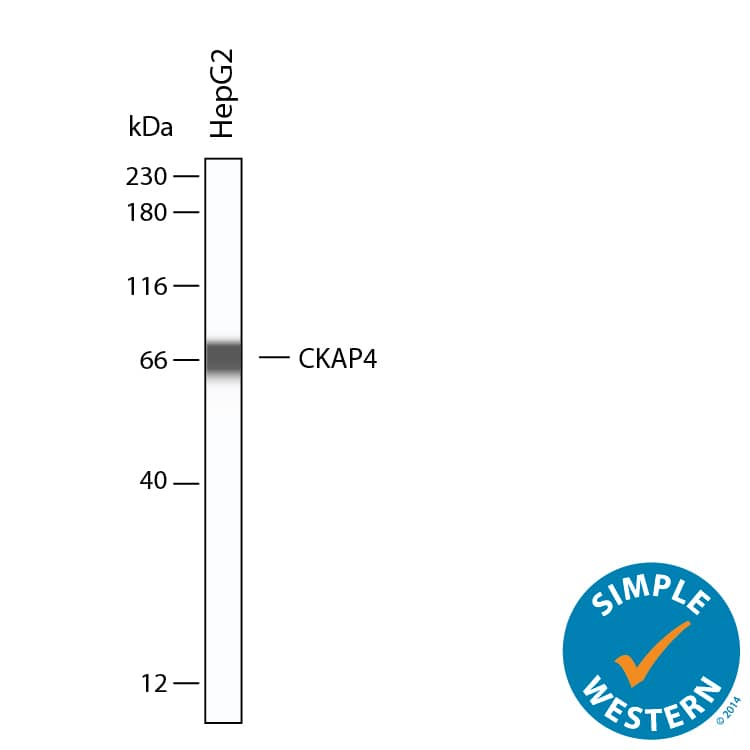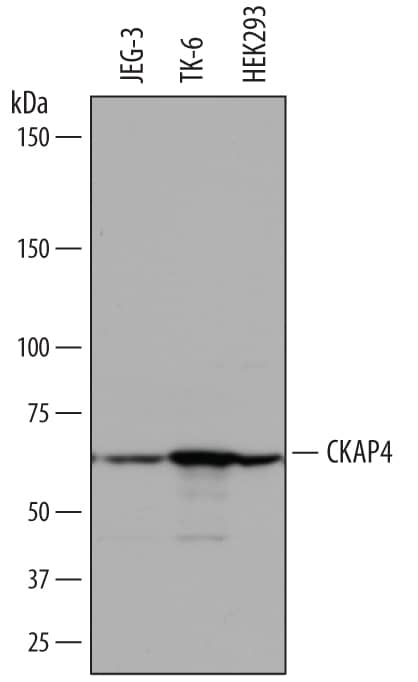Human CKAP4/p63 Antibody
R&D Systems, part of Bio-Techne | Catalog # AF7355

Key Product Details
Species Reactivity
Validated:
Cited:
Applications
Validated:
Cited:
Label
Antibody Source
Product Specifications
Immunogen
His128-Val602
Accession # Q07065
Specificity
Clonality
Host
Isotype
Scientific Data Images for Human CKAP4/p63 Antibody
Detection of Human CKAP4/p63 by Western Blot.
Western blot shows lysates of JEG-3 human epithelial choriocarcinoma cell line, TK-6 human lymphoblast cell line, and HEK293 human embryonic kidney cell line. PVDF membrane was probed with 1 µg/mL of Sheep Anti-Human CKAP4/p63 Antigen Affinity-purified Polyclonal Antibody (Catalog # AF7355) followed by HRP-conjugated Anti-Sheep IgG Secondary Antibody (HAF016). A specific band was detected for CKAP4/p63 at approximately 63 kDa (as indicated). This experiment was conducted under reducing conditions and using Immunoblot Buffer Group 8.CKAP4/p63 in HeLa Human Cell Line.
CKAP4/p63 was detected in immersion fixed HeLa human cervical epithelial carcinoma cell line using Sheep Anti-Human CKAP4/p63 Antigen Affinity-purified Polyclonal Antibody (Catalog # AF7355) at 10 µg/mL for 3 hours at room temperature. Cells were stained using the NorthernLights™ 557-conjugated Anti-Sheep IgG Secondary Antibody (red; NL010) and counterstained with DAPI (blue). Specific staining was localized to cytoplasm. View our protocol for Fluorescent ICC Staining of Cells on Coverslips.CKAP4/p63 in NHEK Human Normal Epidermal Keratinocytes.
CKAP4/p63 was detected in immersion fixed NHEK human normal epidermal keratinocytes using Sheep Anti-Human CKAP4/p63 Antigen Affinity-purified Polyclonal Antibody (Catalog # AF7355) at 10 µg/mL for 3 hours at room temperature. Cells were stained using the NorthernLights™ 493-conjugated Anti-Sheep IgG Secondary Antibody (green; NL012). Cytokeratin 14 was also detected using Mouse Anti-Human Cytokeratin 14 Monoclonal Antibody (MAB3164) and stained using the NorthernLights™ 557-conjugated Anti-Mouse IgG Secondary Antibody (red; NL007). Cells were counterstained with DAPI (blue). Specific staining of CKAP4/p63 was localized to perinuclear space and cell membrane. View our protocol for Fluorescent ICC Staining of Cells on Coverslips.Applications for Human CKAP4/p63 Antibody
Immunocytochemistry
Sample: Immersion fixed HeLa human cervical epithelial carcinoma cell line and NHEK human normal epidermal keratinocytes
Simple Western
Sample: HepG2 human hepatocellular carcinoma cell line
Western Blot
Sample: JEG‑3 human epithelial choriocarcinoma cell line, TK‑6 human lymphoblast cell line, and HEK293 human embryonic kidney cell line
Formulation, Preparation, and Storage
Purification
Reconstitution
Formulation
*Small pack size (-SP) is supplied either lyophilized or as a 0.2 µm filtered solution in PBS.
Shipping
Stability & Storage
- 12 months from date of receipt, -20 to -70 °C as supplied.
- 1 month, 2 to 8 °C under sterile conditions after reconstitution.
- 6 months, -20 to -70 °C under sterile conditions after reconstitution.
Background: CKAP4/p63
CKAP4 (Cytoskeleton-associated protein 4; also CLIMP63 and p63) is a 63-64 kDa molecule that belongs to no known protein family. It is found intracellularly, and on the plasma membrane of select cells such as vascular smooth muscle and Type II Greater alveolar lung cells. CKAP4 has a bimodal distribution. First, it is embedded in the membrane of a compartment that links the ER with the Golgi apparatus. This localization is dependent upon its ability to form homooligomers, and its presence serves to anchor microtubules and direct the formation of tubular ER. Second, it is embedded in the plasma membrane and serves as a receptor for SP-A/surfactant protein-A (in lung) and tPA (in vessels). Human CKAP4 is a 602 amino acid (aa) type II transmembrane nonglycosylated protein. It contains a 106 aa N-terminal cytoplasmic region plus a 475 aa C-terminal luminal domain (aa 128-602). The luminal domain contains three coiled-coil regions (aa 130-214; 256-460; 533-602) plus three utilized phosphorylation sites. CKAP4 undergoes reversible palmitoylation. There are two potential isoform variants. One contains an alternative start at Met269, while another shows a deletion of aa 258-435. Over aa 128-602, human CKAP4 shares 82% aa sequence identity with mouse CKAP4.
Long Name
Alternate Names
Gene Symbol
UniProt
Additional CKAP4/p63 Products
Product Documents for Human CKAP4/p63 Antibody
Product Specific Notices for Human CKAP4/p63 Antibody
For research use only



